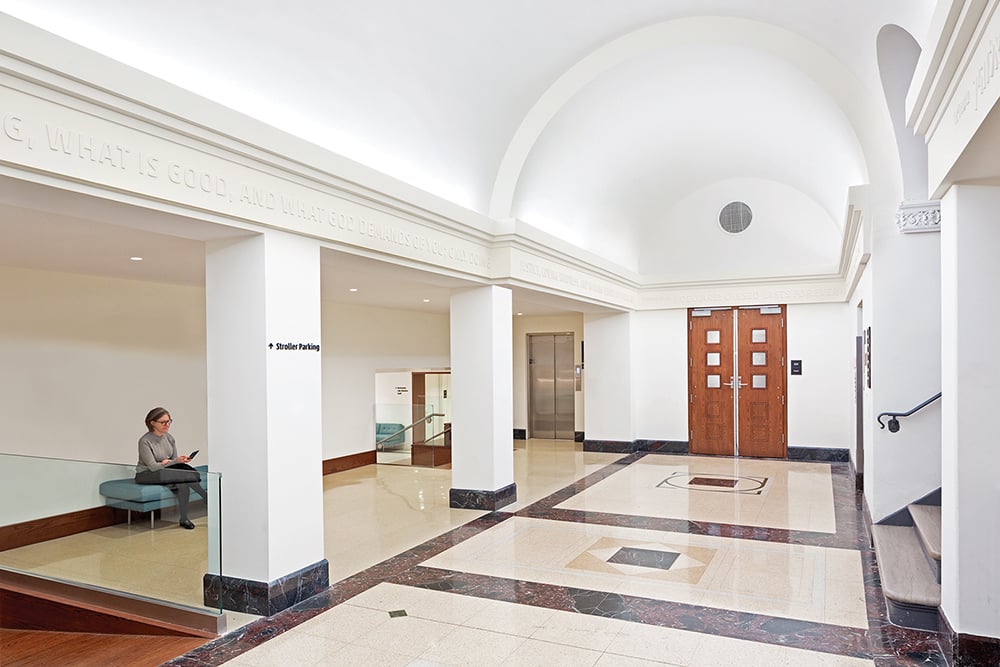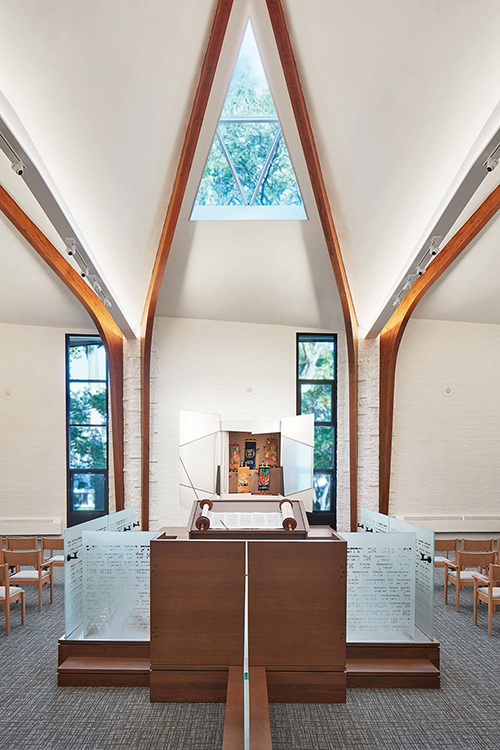
(Courtesy of Studio ST Architects) Renovating an existing synagogue can be intimidating. The design needs to connect to the building’s history and at the same time, embrace contemporary needs. Congregations must decide what aspects of their synagogues to keep and what to change. They also need to balance their long wish list with the available budget and fundraising capacity of the community. Many congregations are emotionally attached to their place of prayer, even when it no longer serves their needs.
Revitalizing synagogues offers the chance to create more functional and meaningful spaces that serve multigenerational congregations. Studio ST Architects have become experts in this area and have recently helped congregations work through these challenging decisions. They find opportunities to make functional improvements and to reinvigorate the spiritual experience for individuals and the community.

Studio ST Architects’ recent renovations of Skokie Valley Synagogue in Skokie, IL and Ansche Chesed Synagogue in New York City are perfect examples of uplifting renovations that respect the historical features and practices, while modernizing the buildings by adding new security, ADA bathrooms, and elevators. The Ansche Chesed Synagogue was built in 1927 and the Skokie Valley Synagogue was built in 1963. Both buildings no longer were able to provide the types of spaces that the community needed.
“We had surveyed the congregation, and making a welcoming, prettier synagogue was what we needed,” said Roberta Shapiro, chair of the fundraising committee at Ansche Chesed. “The hallways were small. On Shabbat we had tons of strollers. Our offices were horrible.”
By relocating Ansche Chesed’s previously windowless offices to the fifth floor, the ground floor lobby area tripled, creating a bright and welcoming space that invites people to hang out. Studio ST Architects restored the original terrazzo floor in the enlarged main lobby and complimented it with a similar terrazzo tile in the new lower lobby. A new coat room with stroller parking can be accessed by a ramp off the lobby. The lower lobby’s oak bleacher-style seating encourages visitors to enjoy each other’s company.
“By having the beautiful coat room and coffee area in the lobby, people can talk with each other and create social connections prior to entering the worship space on Shabbat. It creates warmer feelings throughout,” said Ansche Chesed’s former Executive Director Josh Hanft.
Studio ST Architects improved Ansche Chesed Synagogue’s accessibility and security. A new elevator allows people with mobility challenges to access five different levels of the building with dignity. Relocating the security office and bullet resistant doors to the main entry adds safety to the building. The entry’s steel security doors have bullet resistant glazed openings and are clad in rich wood, simultaneously acting as a safety measure and a seamless design element that respects the synagogue’s historical characteristics.

Redesigning Ansche Chesed’s basement level transformed the outdated social hall and its annex, which is used during weekdays as a gymnastics gym, into a simple yet beautiful space that can accommodate High Holiday services and events. These modern-day upgrades encourage moments of interaction and community, as well as chesed, or loving kindness, as a reflection of the synagogue’s namesake.
Similarly at Skokie Valley Synagogue, Studio ST Architects worked carefully with the congregation to achieve their goals of improving the communal aspects of the sanctuary while making it brighter, more welcoming and accessible. The renovation transformed the sanctuary from a dark and formal room to an ethereal, bright and ADA accessible space for a contemporary congregation. Studio ST Architects created a large triangular skylight in the center of the room, lighting the location of the chazan. They installed minimalistic LED linear cove uplights to wash the original building’s angled roof geometry and illuminate the room with indirect light. The tan brick walls were painted with a coat of white lime wash, brightening the space while respecting its past.
Movable chairs replaced the fixed seats and reoriented the focus of prayer east toward Jerusalem. The new seats provide flexibility and bring the congregation closer to the ark and bimah. The ark and reading table are connected by a raised oak platform with an ADA ramp. The renovation created a pleasant space where people felt more inspired to pray together.
“Skokie Valley Synagogue has served the Jewish community for almost 70 years,” Rabbi Ari Hart of Skokie Valley Synagogue said. “With this renovation, which highlights so many of our core Jewish values of inclusion, accessibility and beauty, we are poised to serve for the next 70 years.”
Studio ST Architects works closely with congregations of all denominations to design beautiful spaces that respect the synagogue’s history while addressing contemporary needs. By listening carefully to each congregation’s unique requirements, Studio ST Architects helped Skokie Valley Synagogue and Ansche Chesed Synagogue create contemporary spaces that allow congregants to have both the communal aspects of praying together and the personal, intimate spiritual experience.
During Skokie Valley Synagogue’s dedication event, Studio ST Architects principal, Esther Sperber, spoke to the community: “As an architect, my job is to listen to clients and congregations and translate their wishes into a physical space. To create a space that is an instrument that can reverberate holiness, community, joy and also moments of sorrow, and allow us to experience those kinds of moments together.”









